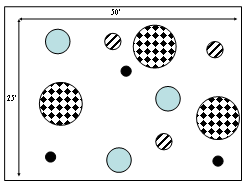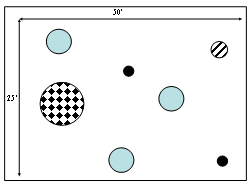Home → Land Resources → Programs → Shoreland Zoning → Clearing Vegetation in the Shoreland Zone (Issue Profile)
Issue Profile
Clearing Vegetation in the Shoreland Zone
Revised: 2018
Contact: Augusta office (207) 287-7688; Portland office (207) 822-6300; Bangor office (207) 941-4570
The information presented in this Issue Profile is based on the standards in the State of Maine Guidelines for Municipal Shoreland Zoning Ordinances (Guidelines). If your community’s locally adopted shoreland zoning ordinance has more restrictive standards those more restrictive provisions apply.
Background
The Mandatory Shoreland Zoning Act requires municipalities to adopt land use regulations for all areas within the shoreland zone. The shoreland zone consists of areas within 250 feet of the normal high-water line of great ponds, rivers, and tidal waters; within 250 feet of the upland edge of non-forested freshwater and coastal wetlands; and within 75 feet of certain streams. Distances are measured horizontally.
The land use controls adopted by the municipalities must be consistent with or no less restrictive than the Board of Environmental Protection's State of Maine Guidelines for Municipal Shoreland Zoning Ordinances.
Do the Guidelines for Municipal Shoreland Zoning Ordinances include limitations on vegetative cutting for development activities in shoreland areas?
Yes. The Guidelines limit the amount of vegetation that can be cut in the shoreland zone. In order to maintain water quality, protect wildlife, and to preserve the natural beauty of shoreland areas, it is important to maintain naturally vegetated shoreland areas. Studies have shown that the removal of natural vegetation and the subsequent conversion of the land to unvegetated surfaces, lawns, or other uniform vegetative cover fails to adequately protect water quality, mostly due to phosphorus and nitrogen runoff (nutrient runoff). An increase in the concentration of phosphorus within a lake of just 1 part per billion can result in a noticeable decrease in water quality.
Nutrient runoff into surface waters can be reduced or prevented by maintaining an uneven-aged stand of trees and other vegetation, including natural ground cover. Furthermore, by leaving the ground surface undisturbed, and by retaining natural depressions for water to collect, nutrients will be removed as water percolates through the upper layers of organic duff.
Water quality is not the only environmental issue affected by the loss of shorefront vegetation. Valuable habitat is lost, and disturbance of wildlife is greatly increased by the loss of a vegetative "screen". As a result, waterfowl, songbirds, shorebirds, and mammal populations are negatively affected.
Although natural beauty is a rather subjective term, most will agree that a Maine coast or inland waterbody with excessive removal of trees and other natural vegetation is not in the best interest of the people of Maine.
What are the restrictions on clearing of vegetation in the shoreland zone?
Generally, in the first 75 feet from the normal high-water line or the upland edge of a wetland, 40% percent of the volume of trees four inches or more in diameter, measured at 4 1/2 feet above ground level can be removed in any ten year period, although no “clear-cut openings” (openings in the forest canopy greater than 250 square feet) are permitted. The cutting must be done such that a well-distributed stand of trees and other vegetation remains. This area is commonly referred to as the buffer strip. Adjacent to great ponds and rivers flowing to great ponds, the buffer strip extends for a distance of 100 feet from the normal high-water line.
Beyond the buffer strip, vegetative cutting limitations are less restrictive. In this area cleared openings are permitted provided that such clearings do not exceed 25% of the lot area, or ten thousand square feet, whichever is greater. In total, however, no more than 40% of the volume of trees can be removed in any 10-year period from the shoreland zone.
Do the Department's Guidelines define a "well-distributed stand of trees and other vegetation"?
The Department's Guidelines define a well-distributed stand of trees and other vegetation by a "point system". This system, which assigns values to trees down to two (2) inches in diameter, requires a certain total value of trees be maintained in each 25-foot by 50-foot square rectangular (1250 square feet) area within the buffer strip.
The tree values are based on tree diameters and are as follows:
| Diameter of tree at 4.5 feet above ground level (inches) |
Points |
|---|---|
| 2 - less than 4 | 1 |
| 4 - less than 8 | 2 |
| 8 - less than 12 | 4 |
| 12 or greater | 8 |
Adjacent to great ponds, and rivers and streams flowing to great ponds, a rating score of 24 or more points must be maintained. Adjacent to other water bodies, tributary streams, and wetlands, a "well-distributed stand of trees and other vegetation" is defined as maintaining a minimum rating score of 16 per 25-foot by 50-foot rectangular area. The point system was created to provide a more enforceable standard for tree cutting activities within the buffer strip.
As an example of the above rating system, adjacent to a great pond, if a 25-foot x 50-foot plot contains three (3) trees between 2 and 4 inches in diameter, three (3) trees between 4 and 8 inches in diameter, three (3) trees between 8 and 12 inches in diameter, and here (3) trees over 12 inches in diameter, the rating score is:
(3x1) + (3x2) +(3x4)+ (3x8) = 45 points
Thus, the 25-foot by 50-foot plot contains trees totaling 45 points. Trees totaling 21 points (45 – 21 = 24) may be removed from the plot provided that no cleared opening is created. The figure below is just one example of allowable cutting under the point system.
Before (45 points)

After (24 points)


NOTE: Some municipalities have a “point system” based on 25-foot by 25-foot plots, rather than 25-foot by 50-foot plots. In those cases the required number of “points” that must be retained is half that required for the larger plots.
Is the cutting of vegetation less than 2 inches in diameter limited?
Yes. State law prohibits new cleared openings from being created within the buffer area. If removal of vegetation less than two inches in diameter will create cleared openings, enough vegetation must be retained to prevent the creation of such openings. Also, if five saplings less than 2 inches in diameter do not exist in a 25-foot by 50-foot plot, no woody stems less than two (2) inches in diameter can be removed until five saplings are recruited into the plot. Furthermore, in order to protect water quality, vegetation less than three (3) feet in height and other groundcover must be maintained within the buffer strip.
Are there areas where the cutting of vegetation is prohibited?
Yes. Vegetative cutting is prohibited abutting a great pond zoned Resource Protection for a distance of 75 feet inland of the normal high-water line, except to remove safety hazards.
Elsewhere, in any Resource Protection District the cutting or removal of vegetation shall be limited to that which is necessary for uses expressly authorized in that district.
May I cut within the buffer strip for shoreline access?
Yes. As long as the area is not located in Resource Protection a footpath not to exceed six (6) feet in width as measured between tree trunks is permitted provided that a cleared line of sight to the water through the buffer strip is not created. In other words, the footpath must meander, rather than being a straight line to the water. The purpose of this limitation is to prevent runoff from funneling directly along the pathway to the water. By meandering the pathway, runoff is more likely to be trapped by vegetation and natural depressions within the buffer strip.
May I prune trees within the buffer strip?
Yes. Pruning of tree branches, on the bottom 1/3 of the tree is permitted. Dead branches are permitted to be pruned without restriction.
What if a cleared opening is created within the buffer area due to storm damage, disease, or the removal of an unsafe tree?
When the removal of storm-damaged, hazard, or dead trees results in the creation of a cleared opening, the opening must be replanted with native tree species, unless existing new tree growth is present.
Can existing cleared openings to the water be maintained?
Yes. Cleared openings legally in existence on the effective date of the ordinance may be maintained. However, areas that were once fields or cleared openings, but have reverted to primarily shrubs, trees, or other woody vegetation are regulated as any other buffer area under the ordinance.
If I adhere to the "Clearing of Vegetation For Development" Standards in the Department's Guidelines will I be sure that I am in compliance with all clearing limitations?
No. Local ordinances may be more restrictive. You should always consult with you local code enforcement officer before your begin clearing of vegetation in the shoreland zone.